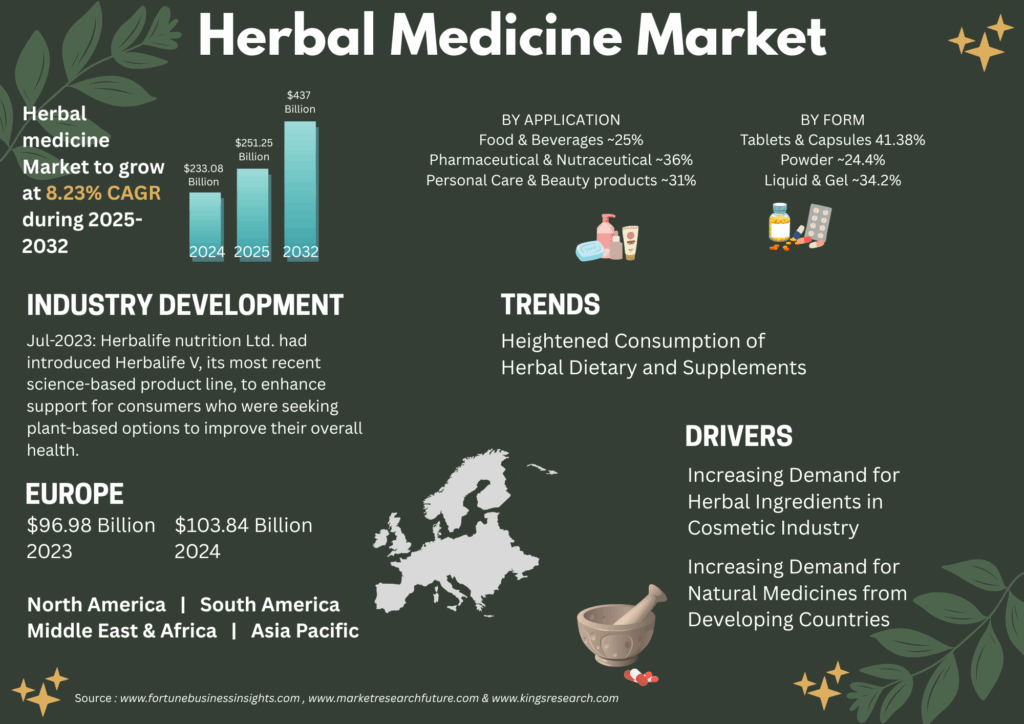Herbal Medicine Market Growth & Trends
The herbal medicine market is projected to grow from USD 233.08 billion in 2024 to approximately USD 437 billion by 2032, representing a compound annual growth rate (CAGR) of 8.23%. Europe currently holds the largest market share, while Asia-Pacific is anticipated to be the fastest-growing region, reflecting a surge in demand for natural health products. This growth is fueled by increasing consumer demand for natural health solutions, the integration of traditional medicine systems into modern healthcare, and advancements in personalized herbal products which refers to customized natural remedies or wellness items that are tailored to an individual’s unique needs, preferences, or health conditions (1).
Due to the growing demand for natural health products and traditional treatment approaches, the global herbal commerce and business have experienced tremendous growth. The business, which has its origins in traditional therapeutic methods, is now crucial to contemporary wellness thanks to developments in organic living, sustainability, and preventative healthcare. According to the World Health Organization (WHO), around 80% of the world’s population consults traditional health practitioners for plant-based medicines, as they believe that products labelled as ‘natural’ are safe to consume and do not have any side effects on their health. The growing integration of traditional medicine systems like Ayurveda and Traditional Chinese Medicine (TCM) contributes to expanding the market, as their holistic approaches gain global recognition. The improvements in extraction techniques and enhanced quality standards are driving increased integration and better therapeutic outcomes (2).
The market for herbal medicines was dominated by Europe in 2023, with a 44.82% market share. Increasing rates of chronic diseases, an ageing population, and a growing inclination towards plant-based treatments all contribute to the region’s rise (1). In the meantime, Asia-Pacific is expanding quickly due to factors like a lengthy history of traditional medicine, growing consumer awareness of natural medicines, and rising healthcare expenditures. Countries like China, Japan, and India are some of the nations that make major contributions to the market’s growth (3).
Advances in traditional medical systems, technological improvements, and growing consumer demand for natural and holistic health solutions are all driving significant growth in the herbal medicine industry. In the upcoming years, the market for herbal medications is anticipated to continue growing as consumers become more health-conscious and look for alternatives to conventional treatments.

References
- Herbal Medicine Market Size, Share, Growth Analysis, 2032 (2025). Fortune Business Insight. Available at: https://www.fortunebusinessinsights.com/herbal-medicine-market-106320
- Herbal medicine market size to reach $328.72Bn by 2030 (2024). Grand View Research. Available at: https://www.grandviewresearch.com/press-release/global-herbal-medicine-market
- Herbal Medicine Market (By Intervention: Ayurveda, Traditional Chinese Medicine; By Product Form: Tablet/Capsules, Powder; By Source; By Distribution Channel) – Global Industry Analysis, Size, Share, Growth, Trends, Revenue, Regional Outlook and Forecast 2024-2033. (2014). Vision Research Reports. Available at: https://www.visionresearchreports.com/herbal-medicine-market/41379

